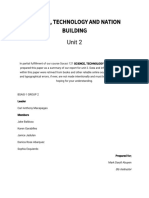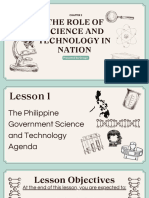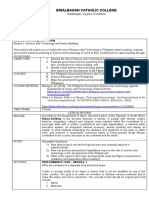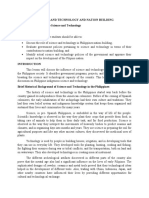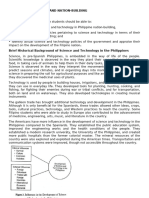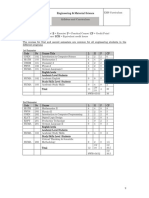Science, Technology, and Nation-Building
Science, Technology, and Nation-Building
Uploaded by
Niño Felipe IgnacioCopyright:
Available Formats
Science, Technology, and Nation-Building
Science, Technology, and Nation-Building
Uploaded by
Niño Felipe IgnacioOriginal Description:
Original Title
Copyright
Available Formats
Share this document
Did you find this document useful?
Is this content inappropriate?
Copyright:
Available Formats
Science, Technology, and Nation-Building
Science, Technology, and Nation-Building
Uploaded by
Niño Felipe IgnacioCopyright:
Available Formats
GE 7 – SCIENCE, TECHNOLOGY AND SOCIETY
TEMPLATE
BSED MATH 2A
SECOND Semester, A.Y. 2020-2021
I. Chapter: 1
II. Lesson Number: 2
III. Lesson Title SCIENCE, TECHNOLOGY, AND NATION-BUILDING
IV. Learning Objectives: At the end of this lesson, the students should be able to:
discuss the role of science and technology in Philippine
nation-building;
evaluate government policies pertaining to science and
technology in terms of their contributions to nation-building;
and
identify actual science and technology policies of the
government and appraise their impact on the development of
the Filipino nation.
V. Content:
Brief Historical Background of Science and Technology in the Philippines
Science and technology in the Philippines started way back before the country gained its
independence from the American colonizers.
Science in the pre-Spanish Philippines is embedded in the way of life of the people.
Scientific knowledge is observed in the way they plant their crops that provide them
food, in taking care of animals to help them in their daily tasks, and for food production.
Technology is used by people in building houses, irrigations and in developing tools that
they can use in everyday life.
The different archeological artifacts discovered in different parts of the country also
prove that the Metal Age also had a significant influence on the lives of early Filipinos.
All these ancient practices in science and technology are considered now as indigenous
science or folk science.
When the Spaniards colonized the country, they brought with their own culture and
practices. They established schools for boys and girls and introduced the concept of
subjects and disciplines. It was the beginning of formal science and technology in the
country, known now as school of science and technology.
Learning of science in school focuses on understanding different concepts related to the
human body, plants, animals and heavenly bodies.
Life during the Spanish era slowly became modernized, adapting some Western
technology and their ways of life. The Filipinos developed ways to replicate the
technology brought by the Spaniards using indigenous materials.
The galleon trade has brought additional technology and development in the Philippines.
Although it is only beneficial for the Spaniards, these trades allowed other ideas, crops,
tools, cultural, practices, technology, and Western practices to reach the country.
The Philippines, being one of the centers of global trade in Southeast Asia during that
time, was considered to be one of the most developed places in the region.
The Americans have more influence in the development of science and technology in
the Philippines compares to the Spaniards. They established the public education
system, improved the engineering works and the health conditions of the people. They
established a modern research university, the University of the Philippines, and created
more public hospitals than the former colonial master.
The Americans did everything to “Amercanize” the Philippines. They reorganized the
learning of science and introduced it in public and private schools. In basic education,
1|Page MARICEL D. YUMUL (Instructor) 2020
GE 7 – SCIENCE, TECHNOLOGY AND SOCIETY
TEMPLATE
BSED MATH 2A
SECOND Semester, A.Y. 2020-2021
science education focuses on nature studies and science and sanitation, until it
became a subject formally known as “Science”.
The desire of the Americans to develop the human resources of the Philippines to serve
their own interests is, somehow, beneficial in the country. These allowed American
scholars to introduce new knowledge and technology in the country. The Protestant
church missions in different places in the country also brought hospitals and schools to
far-flung areas.
World War II has destabilized the development of the country in many ways. Institutions
and public facilities were turned into ashes, houses were burned, and many lives were
destroyed. The reparation funds focused on building some institutions and public
facilities like schools, hospitals and transportation systems. The reparation money from
Japan was also concentrated on building highways and in providing technological
training and human resource development in the country.
The establishment of the new republic has explored the use of ODA or Overseas
Development Allocations from different countries to help the country improve its scientific
productivity and technological capability. Human resource development is at the heart of
these efforts focusing on producing more engineers, scientists, technology experts,
doctors, and other professionals in the country.
The development of science and technology in the Philippines, based on its brief history,
is shaped by several factors and influences.
Figure 3. Influences in the Development of Science
and Technology in the Philippines
Science and technology may have significant impact on the lives of the people and in the
development of the Philippine society. However, improving the quality of science
education still remains as a big challenge in the country.
Government Policies on Science and Technology
The Philippine government introduced and implemented several programs, projects, and
policies to boost the area of science and technology.
Padilla-Concepcion (2015) reported that in 2015, in response to the ASEAN 2015
Agenda, the government, particularly the Department of Science and Technology
(DOST), has sought the expertise of the National Research Council of the Philippines
(NCRP) to consult various sectors in the society to study how the Philippines can
prepare itself in meeting the ASEAN 2015 Goals. As a result of the consultation, the
NCRP is expected to recommend policies and programs that will improve the
competitiveness of the Philippines in the ASEAN Region.
2|Page MARICEL D. YUMUL (Instructor) 2020
GE 7 – SCIENCE, TECHNOLOGY AND SOCIETY
TEMPLATE
BSED MATH 2A
SECOND Semester, A.Y. 2020-2021
The NCRP clustered these policies into four, namely:
1. Social Sciences, Humanities, Education, International Policies and Governance
Integrating ASEAN awareness in basic education without adding to the
curriculum
Emphasizing teaching in the mother tongue
Developing school infrastructure and providing for ICT broadband
Local food security
2. Physics, Engineering and Industrial Research, Earth and Space Sciences, and
Mathematics
Emphasizing degrees, licenses, and employment opportunities
Outright grants for peer monitoring
Review of R.A. 9184
Harnessing science and technology as an independent mover of
development
3. Medical, Chemical, and Pharmaceutical Sciences
Ensuring compliance of drug-manufacturing firms with ASEAN-
harmonized standards by full implementation of the Food and Drug
Administration
Creating an education council dedicated to standardization of
pharmaceutical services and care
Empowering food and drug agencies to conduct evidence-based research
as pool of information
Allocating two percent of the GDP to research
Legislating a law supporting human genome projects
4. Biological Sciences, Agriculture, and Forestry
Protecting and conserving biodiversity by full implementation of existing
laws
Use of biosafety and standard model by ASEAN countries
Promoting indigenous knowledge systems and indigenous people’s
conservation
Formulation of common food and safety standards
There are also other existing programs supported by the Philippine government through
the DOST. Some of these projects are the following:
Providing funds for basic research and patents related to science and
technology.
Providing scholarships for undergraduate and graduate studies of students in the
field of science and technology.
Establishing more branches of the Philippine Science High School System for
training young Filipinos in the field of science and technology.
Creating science and technology parks to encourage academe and industry
partnerships.
Balik Scientist Program to encourage Filipino scientists abroad to come home
and work in the Philippines or conduct research and projects in collaboration with
Philippine-based scientists.
Developing science and technology parks in academic campuses to encourage
academe and industry partnerships.
The establishment of the National Engineering Complex within the University of
the Philippines campus in Diliman.
The Philippine-American Academy of Science and Engineering (PAASE, 2008) identified
several capacity-building programs such as:
Establishment of national centers of excellence
Manpower and institutional development programs, such as the Engineering and
Science Education Program (ESEP) to produce more PhD graduates in science
and engineering
Establishment of regional centers to support specific industries that will lead the
country in different research and development areas
3|Page MARICEL D. YUMUL (Instructor) 2020
GE 7 – SCIENCE, TECHNOLOGY AND SOCIETY
TEMPLATE
BSED MATH 2A
SECOND Semester, A.Y. 2020-2021
Establishment of science and technology business centers to assist, advise,
and incubate technopreneurship ventures
Strengthen science education at an early stage through the Philippine Science
High School system
In the field of education, several science-related programs and projects were created to
develop the scientific literacy of the country. The current K to 12 education program
included Science, Technology, Engineering, and Mathematics (STEM) as one of its
major tracks in the senior high school program to encourage more students to enroll in
science-related field in college.
The Commission on Higher Education launched its Philippine-California Advanced
Research Institutes (PICARI) Project to allow several higher education institutions in the
Philippines and some US-based laboratories, research institutes, and universities to
work on research and projects related to science, agriculture, engineering, health, and
technology.
There are many other areas and fields that the country is looking forward to embark
various research and projects. The following are some of them:
1. Use of alternative and safe energy
2. Harnessing mineral resources
3. Finding cure for various diseases and illness
4. Climate change and global warming
5. Increasing food production
6. Preservation of natural resources
7. Coping with natural disasters and calamities
8. Infrastructure development
The Philippine Congress has also created various laws related to science and
technology. These laws serve as a legal framework for science and technology in the
country. These laws vary according to different themes. Some laws and policies are in
line with international treaties.
Figure 4. Development of Science and Technology Policies in the Philippines
As shown in the diagram, the development of policies in science and technology is
shaped or influenced by several variables: policies need to be aligned to national goals,
consider international commitments based on legal frameworks, and respond to various
social needs, issues, and problems.
4|Page MARICEL D. YUMUL (Instructor) 2020
GE 7 – SCIENCE, TECHNOLOGY AND SOCIETY
TEMPLATE
BSED MATH 2A
SECOND Semester, A.Y. 2020-2021
Famous Filipinos in the Field of Science
School science is filled with names of foreign scientists: Einstein, Galileo Galilei,
Newton, Faraday, Darwin, and many other Western scientists. We rarely hear of Filipino
scientists being discussed in science classes. Lee-Chua (2000) identified 10 outstanding
Filipino scientists who have made significant contributions in Philippine science.
These Filipino scientists are:
1. Ramon Cabanos Barba – for his outstanding research on tissue culture in
Philippine mangoes
2. Josefino Cacas Comiso – for his works on observing the characteristics of
Antarctica by using satellite images
3. Jose Bejar Cruz Jr. – known internationally in the field of electrical engineering;
was elected as officer of the famous Institute of Electrical and Electronic
Engineering
4. Lourdes Jansuy Cruz – notable for her research on sea snail venom
5. Fabian Millar Dayrit – for his research on herbal medicine
6. Rafael Dineros Guerrero III – for his research on tilapia culture
7. Enrique Mapua Ostrea Jr. – for inventing the meconium drugs testing
8. Lilian Formalejo Patena – for doing research on plant biotechnology
9. Mari-Jo Panganiban Ruiz – for being an outstanding educator and graph theorist
10. Gregory Ligot Tangonan – for his research in the field of communications
technology.
There are other outstanding Filipino scientists who are recognized here and abroad for
their outstanding contributions in science:
Caesar A. Saloma – an internationally renowned physicist
Edgardo Gomez – famous scientist in marine science
William Padolina – chemistry and president of National Academy of Science and
Technology (NAST)–Philippines
Angel Alcala – marine science
There are other scientists in the Philippines who were not identified in the list. The
University of the Philippines–Los Baños is a science paradise for agriculture, forestry,
plant and animal science, and veterinary science. The University of the Philippines–
Visayas is also a national center for marine science, fisheries, and other related
sciences. The University of the Philippines–Manila is a center of excellence and has
produced many researchers, doctors, health professionals, and scientists in the area of
medical and public health. The University of the Philippines–Diliman also has
established a national science and engineering complex to develop more research and
produce more scientists and engineers in the country. The government must find ways
to establish more research laboratories and research institutes.
Many of these Filipino scientists are products of good school science. It means they
were taught and inspired by great teachers. Their interests in science started to manifest
during their childhood years. Their natural environment ignited their curiosity to learn
more about the natural and physical environment. Schools and the laboratories where
they studied and worked nurtured this.
5|Page MARICEL D. YUMUL (Instructor) 2020
GE 7 – SCIENCE, TECHNOLOGY AND SOCIETY
TEMPLATE
BSED MATH 2A
SECOND Semester, A.Y. 2020-2021
Figure 5. Factors that Influence the Development of Filipino Scientists
Many Filipino scientists, whether they are in the country or abroad, always excel in their
job. The Filipino spirit in their souls has never faded. They make ordinary things in an
extraordinary way. They are always at par with other scientists in spite of the limited
facilities we have here in the country.
Prepared by: Noted:
CUTCHON, ANGELICA V.
LUMBA, AIRON E.
GUTIERREZ, CEEJAY F.
(BSED MATH 2A)
Name of Student/s MARICEL D. YUMUL
Course/Year/ Section Instructor
6|Page MARICEL D. YUMUL (Instructor) 2020
You might also like
- DLL Science Grade7 Quarter1 Week1 (Palawan Division)Document5 pagesDLL Science Grade7 Quarter1 Week1 (Palawan Division)gretchelle87% (31)
- Engineering Levels ChartDocument1 pageEngineering Levels ChartBinu SulochananNo ratings yet
- List of Laboratories in KZN and GautengDocument6 pagesList of Laboratories in KZN and GautengLungisani50% (2)
- Lesson 2 Science, Technology, and Nation-BuildingDocument5 pagesLesson 2 Science, Technology, and Nation-Buildingcamille guiaoNo ratings yet
- Science and Technology and The Nation-BuildingDocument7 pagesScience and Technology and The Nation-BuildingKclyn Remolona100% (3)
- Science Technology and SocietyDocument9 pagesScience Technology and Societyminejasminejas.17No ratings yet
- STS2 PrelimDocument10 pagesSTS2 PrelimCharis RebanalNo ratings yet
- Hand Out 3Document9 pagesHand Out 3Mae TadaNo ratings yet
- STS 1 Module 3Document10 pagesSTS 1 Module 3Krizzle May CastroNo ratings yet
- Science and Technology and Nation BuildingDocument15 pagesScience and Technology and Nation BuildingNorodin A. RangaigNo ratings yet
- Sts Hand Outs 2Document12 pagesSts Hand Outs 2apriljirahmaelopezNo ratings yet
- CH 3 Lesson 1Document9 pagesCH 3 Lesson 1Judy Fe Bay-anNo ratings yet
- CH 3 Lesson 1 - UpdatedDocument8 pagesCH 3 Lesson 1 - UpdatedFreda Buking DayogNo ratings yet
- Module 1: Science, Technology, and SocietyDocument9 pagesModule 1: Science, Technology, and SocietyElla Mae LayarNo ratings yet
- Lesson 2: Science,, and Nation-BuildingDocument30 pagesLesson 2: Science,, and Nation-Buildingayessa may magayonNo ratings yet
- Science, Technology, and Nation-BuildingDocument5 pagesScience, Technology, and Nation-BuildingJewela Arquillano PlamaNo ratings yet
- Chapter 3Document35 pagesChapter 3delrosario.kenneth996No ratings yet
- Lesson 2:: Science and Technology and Nation BuildingDocument15 pagesLesson 2:: Science and Technology and Nation Buildingjeyyy BonesssNo ratings yet
- Brief Historical Background of Science and Technology in The PhilippinesDocument27 pagesBrief Historical Background of Science and Technology in The PhilippinesIrish Dianne TulodNo ratings yet
- Lesson 2 STSDocument28 pagesLesson 2 STSKayeAnne Mesina BibonNo ratings yet
- STS Module 2Document4 pagesSTS Module 2monesallenjayNo ratings yet
- Sts Module 2Document8 pagesSts Module 2rodalyn malanaNo ratings yet
- Science Technology and SocietyDocument7 pagesScience Technology and SocietyGennelyn Lairise RiveraNo ratings yet
- Group 1 STS ReportDocument37 pagesGroup 1 STS ReportGleanne Margaret GatpolintanNo ratings yet
- Science, Technology and Nation-Building: ObjectivesDocument5 pagesScience, Technology and Nation-Building: ObjectivesKris MontesNo ratings yet
- Lesson 1.3. Science, Technology and Nation-BuildingDocument8 pagesLesson 1.3. Science, Technology and Nation-BuildingJames MichaelNo ratings yet
- BSCRIM2E_STS_CHAPTER 1_LESSON 3_GROUP 1Document8 pagesBSCRIM2E_STS_CHAPTER 1_LESSON 3_GROUP 1Iris May DeocampoNo ratings yet
- Chapter 3 Nation BuildingDocument9 pagesChapter 3 Nation BuildingAlly Capacio100% (1)
- Lesson 2 - STSDocument17 pagesLesson 2 - STS28christiandaveNo ratings yet
- CHAPTER - 3 - MSWORD - Docx Filename - UTF-8''CHAPTER 3 MSWORDDocument8 pagesCHAPTER - 3 - MSWORD - Docx Filename - UTF-8''CHAPTER 3 MSWORDCaurrine MonsaludNo ratings yet
- REPORT NI CLIENTDocument11 pagesREPORT NI CLIENTmusicpreskoNo ratings yet
- Lesson 3 StsDocument4 pagesLesson 3 StsllaavvhiNo ratings yet
- sts reportingDocument9 pagessts reportingerickha galvezNo ratings yet
- Binalbagan Catholic CollegeDocument7 pagesBinalbagan Catholic CollegeMaybelleNo ratings yet
- Scienceandtechnonolyandnationbuilding Lecturenotes 190113143211Document4 pagesScienceandtechnonolyandnationbuilding Lecturenotes 190113143211elladanicajNo ratings yet
- STS Chapter 3Document15 pagesSTS Chapter 3Chrisbelle Jenn Apaling SawadanNo ratings yet
- Science Technology and Nation BuildingDocument4 pagesScience Technology and Nation BuildingCholophrex SamilinNo ratings yet
- Lesson 2 Science Technology and Nation BuildingDocument9 pagesLesson 2 Science Technology and Nation Buildingotherpurposes496No ratings yet
- Sts Paper FinalDocument22 pagesSts Paper FinalVianca Aubrey SisikNo ratings yet
- STSDocument37 pagesSTSIrenejoy Ramirez0% (1)
- Science and Technology and Nation BuildingDocument4 pagesScience and Technology and Nation BuildingTa dsNo ratings yet
- Science Teachnology and Society Midterms ReviewerDocument9 pagesScience Teachnology and Society Midterms ReviewerFlorence Heart ViñasNo ratings yet
- Lesson 2 ST Nation BuildingDocument100 pagesLesson 2 ST Nation BuildingVinNo ratings yet
- Chapter II Lesson 1 The Philippine Government Science and Technology AgendaDocument16 pagesChapter II Lesson 1 The Philippine Government Science and Technology AgendaalissonjaytabierosNo ratings yet
- STS - Module 2Document6 pagesSTS - Module 2DANIEL SETH LAYUGNo ratings yet
- StsDocument59 pagesStsPatriciacamille Austria100% (2)
- Lesson 2 - Science, Technology, & Nation-BuildingDocument9 pagesLesson 2 - Science, Technology, & Nation-BuildingVijanes Beltrans100% (1)
- Brief Historical Background of Science and Technology in The PhilippinesDocument14 pagesBrief Historical Background of Science and Technology in The PhilippinesJomeljames Campaner PanganibanNo ratings yet
- Science and Technology and Nation Building: Learning Experiences & Self-Assessment Activities (Saa)Document15 pagesScience and Technology and Nation Building: Learning Experiences & Self-Assessment Activities (Saa)Rofil Albao100% (2)
- STS Group 3Document6 pagesSTS Group 3rosetemira8No ratings yet
- Chapter 1 Lesson 2 Continuation TopicDocument5 pagesChapter 1 Lesson 2 Continuation TopicKyla Mae LucianoNo ratings yet
- GE 7 ReportDocument31 pagesGE 7 ReportMark Anthony FergusonNo ratings yet
- Lesson 2: Science, Technology and Nation BuildingDocument29 pagesLesson 2: Science, Technology and Nation Building12 ABM 2A-BORRES, JEAN ROSENo ratings yet
- Central Bicol State University of Agriculture Pasacao CampusDocument11 pagesCentral Bicol State University of Agriculture Pasacao CampusGilda Genive AriolaNo ratings yet
- STS Prelim Chapter 1Document14 pagesSTS Prelim Chapter 1Veronica DyNo ratings yet
- Module 2 Sci, Tech & Nation BuildingDocument8 pagesModule 2 Sci, Tech & Nation Buildingsarah.sardonNo ratings yet
- Bsed Gec107 SLM2Document8 pagesBsed Gec107 SLM2Chelzy Anne HernandezNo ratings yet
- Assignment 4 STS John Aldrich Rivera Bamm 1-DDocument2 pagesAssignment 4 STS John Aldrich Rivera Bamm 1-Djohnaldrichrivera09No ratings yet
- STS Midterm TopicsDocument14 pagesSTS Midterm TopicsWil LiamNo ratings yet
- STS G3 (1) - 030712Document72 pagesSTS G3 (1) - 030712Alvin Isulan PerezNo ratings yet
- Lesson 3 Government Policies On Science and TechnologyDocument33 pagesLesson 3 Government Policies On Science and Technologyconan juarbalNo ratings yet
- Outline in STS Group - 3 SummaryDocument2 pagesOutline in STS Group - 3 SummaryAdelyne DetablanNo ratings yet
- Science Communication in South Africa: Reflections on Current IssuesFrom EverandScience Communication in South Africa: Reflections on Current IssuesNo ratings yet
- Oracle SHUTDOWN: Introduction To The Oracle StatementDocument3 pagesOracle SHUTDOWN: Introduction To The Oracle StatementTanmoy NandyNo ratings yet
- Mini Project Report On: "Study On Operation & Maintanance of 400/220 KV SUBSTATION"Document4 pagesMini Project Report On: "Study On Operation & Maintanance of 400/220 KV SUBSTATION"shiva patelNo ratings yet
- STS 2411 - Lecture 8 - The Social Construction of TechnologyDocument2 pagesSTS 2411 - Lecture 8 - The Social Construction of TechnologyJoseph Ajayi FAYOMINo ratings yet
- 7951 FD 01Document54 pages7951 FD 01Abuzar KhanNo ratings yet
- Automatizationpresentacion InglesDocument8 pagesAutomatizationpresentacion InglesAdriana LeyvaNo ratings yet
- Yusuf Original Jamb ResultDocument1 pageYusuf Original Jamb ResultaroNo ratings yet
- Annexure Annauniversity of Technology Madurai Faculty Data SheetDocument3 pagesAnnexure Annauniversity of Technology Madurai Faculty Data SheetSmart BkNo ratings yet
- EngineeringDocument187 pagesEngineeringMuhammad SaleemNo ratings yet
- Bachelor of Engineering (Honours) (Civil) - All Majors-Semester 1 StartDocument20 pagesBachelor of Engineering (Honours) (Civil) - All Majors-Semester 1 StartFaycel HIZINo ratings yet
- (ICRTCCM'2016) : Universtity College of Engineering TindivanamDocument2 pages(ICRTCCM'2016) : Universtity College of Engineering TindivanamGajalakshmi RavisankarNo ratings yet
- Week 1 Quiz - Introduction To AI - Week 1 Quiz - Introduction To AI - CSMMDocument5 pagesWeek 1 Quiz - Introduction To AI - Week 1 Quiz - Introduction To AI - CSMMRaj kumar manepallyNo ratings yet
- Ssoc 2010Document440 pagesSsoc 2010Xin LiNo ratings yet
- Tesda Accredited SchoosDocument4 pagesTesda Accredited SchoosMichelle TaniecaNo ratings yet
- Aqib Javed: EducationDocument1 pageAqib Javed: EducationMubasher HasanNo ratings yet
- Resume - Rouhollah Rahmani, 2015-11-04Document5 pagesResume - Rouhollah Rahmani, 2015-11-04hadi100% (1)
- SAEzzmarDocument7 pagesSAEzzmarfarchipmm58No ratings yet
- Mechatronics CurriculumDocument4 pagesMechatronics CurriculumAHMED0% (1)
- NTIF General GuidelinesDocument6 pagesNTIF General GuidelinesJohnny EnglishNo ratings yet
- IMPORTANNT: This Registration Form Is Only Valid For The Year and Semester Stated in The Student's Information. This Serves As Your ProofDocument3 pagesIMPORTANNT: This Registration Form Is Only Valid For The Year and Semester Stated in The Student's Information. This Serves As Your ProofBTCI LUCBANNo ratings yet
- Result GEC SreekrishnapuramDocument7 pagesResult GEC SreekrishnapuramAnonymous DbmKEDxNo ratings yet
- PSD02 - Data Science OverviewDocument64 pagesPSD02 - Data Science OverviewEren YeagerNo ratings yet
- Rejection ListDocument356 pagesRejection ListTrilikita ReddyNo ratings yet
- Presentation Schedule2010BWFLYER FinalDocument1 pagePresentation Schedule2010BWFLYER FinalRamon Salsas EscatNo ratings yet
- Chapter 34 Java Database ProgrammingDocument4 pagesChapter 34 Java Database ProgrammingAleksandar PečenkovićNo ratings yet
- Indian Institute of Technology KharagpurDocument3 pagesIndian Institute of Technology KharagpurDebamitra MukherjeeNo ratings yet
- Events Management: Mark Raymond M. Pitoc, MMCDocument19 pagesEvents Management: Mark Raymond M. Pitoc, MMCFILESONICNo ratings yet
- Walter P MooreDocument2 pagesWalter P MooreRajed MaglinteNo ratings yet





